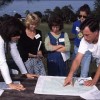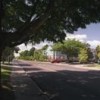 A result of the influx of new residents to the South is an expansion of urban areas into forests and other natural areas, creating areas referred to as the wildland-urban interface. Interface issues of most concern vary from state to state, but some key issues are consistent across the South. the US Forest Service conducted a series of focus groups in 2000. Key issues gleaned from those focus groups and other related sources are described in this 5-page fact sheet written by L. Annie Hermansen-Baez, Jennifer Seitz, and Martha C. Monroe, and published by the UF Department of School of Forest Resources and Conservation, February 2013.
A result of the influx of new residents to the South is an expansion of urban areas into forests and other natural areas, creating areas referred to as the wildland-urban interface. Interface issues of most concern vary from state to state, but some key issues are consistent across the South. the US Forest Service conducted a series of focus groups in 2000. Key issues gleaned from those focus groups and other related sources are described in this 5-page fact sheet written by L. Annie Hermansen-Baez, Jennifer Seitz, and Martha C. Monroe, and published by the UF Department of School of Forest Resources and Conservation, February 2013.
http://edis.ifas.ufl.edu/fr264
Tag: Jennifer A. Seitz
The Costs of Managing an Urban Forest (FOR217/FR279)
 Urban forests provide benefits to society often referred to as ecosystem services: they improve human health, environmental quality, and local economies by increasing property values and aesthetics in communities. They help cities control storm water, reduce air pollution and energy costs, and offset carbon dioxide emissions. But urban forests also have “ecosystem disservices.” An accurate assessment of an urban forest’s costs can assist decision makers to better understand the role the forest plays in improving the well-being of the community. Identifying how funding is used can also help communities minimize costs and increase benefits. This 4-page fact sheet will review some of the types of costs associated with urban forests and present typical financial costs associated with urban forest management in the city of Gainesville, Florida. Written by Francisco Escobedo and Jennifer Seitz, and published by the UF Department of School of Forest Resources and Conservation, October 2012.
Urban forests provide benefits to society often referred to as ecosystem services: they improve human health, environmental quality, and local economies by increasing property values and aesthetics in communities. They help cities control storm water, reduce air pollution and energy costs, and offset carbon dioxide emissions. But urban forests also have “ecosystem disservices.” An accurate assessment of an urban forest’s costs can assist decision makers to better understand the role the forest plays in improving the well-being of the community. Identifying how funding is used can also help communities minimize costs and increase benefits. This 4-page fact sheet will review some of the types of costs associated with urban forests and present typical financial costs associated with urban forest management in the city of Gainesville, Florida. Written by Francisco Escobedo and Jennifer Seitz, and published by the UF Department of School of Forest Resources and Conservation, October 2012.
http://edis.ifas.ufl.edu/fr279
Carbon Sequestration and Storage by Gainesville’s Urban Forest (FOR210/FR272)
 Cities are a major source of carbon dioxide emissions. This fact sheet demonstrates that urban and natural trees can help mitigate the effects of climate change somewhat by sequestering CO2 but can only sequester a small portion of all carbon dioxide emitted from cities. In addition, decomposing trees and mulch, tree maintenance activities, and improperly placed trees that cause shading in winter can also result in emissions of CO2, so it is important for communities to reduce fossil fuel emissions and manage for and preserve large, healthy trees to maximize the amount of CO2 sequestered by an urban forest. This 3-page fact sheet was written by Francisco Escobedo, Jennifer A. Seitz, and Wayne Zipperer, and published by the UF Department of School of Forest Resources and Conservation, February 2012.
Cities are a major source of carbon dioxide emissions. This fact sheet demonstrates that urban and natural trees can help mitigate the effects of climate change somewhat by sequestering CO2 but can only sequester a small portion of all carbon dioxide emitted from cities. In addition, decomposing trees and mulch, tree maintenance activities, and improperly placed trees that cause shading in winter can also result in emissions of CO2, so it is important for communities to reduce fossil fuel emissions and manage for and preserve large, healthy trees to maximize the amount of CO2 sequestered by an urban forest. This 3-page fact sheet was written by Francisco Escobedo, Jennifer A. Seitz, and Wayne Zipperer, and published by the UF Department of School of Forest Resources and Conservation, February 2012.
http://edis.ifas.ufl.edu/fr272
The Effect of Gainesville’s Urban Trees on Energy Use of Residential Buildings (FOR211/FR273)
 Based on a 2007 average retail price of electricity in Florida, trees in Gainesville are estimated to provide about $1.9 million in savings each year due to reduced air conditioning and heating use. However, trees also increase energy costs in winter by approximately $367 thousand annually because their shade cools buildings and thus raises building heating costs. This 3-page fact sheet was written by Francisco Escobedo, Jennifer A. Seitz, and Wayne Zipperer, and published by the UF Department of School of Forest Resources and Conservation, February 2012.
Based on a 2007 average retail price of electricity in Florida, trees in Gainesville are estimated to provide about $1.9 million in savings each year due to reduced air conditioning and heating use. However, trees also increase energy costs in winter by approximately $367 thousand annually because their shade cools buildings and thus raises building heating costs. This 3-page fact sheet was written by Francisco Escobedo, Jennifer A. Seitz, and Wayne Zipperer, and published by the UF Department of School of Forest Resources and Conservation, February 2012.
http://edis.ifas.ufl.edu/fr273
FOR220/FR282 Addressing Sunshine State Standards in Elementary School Teacher Professional Development Workshops
FOR-220, a 6-page illustrated fact sheet by Jennifer A. Seitz, Martha C. Monroe, and Kimberly O. Thurman, use Project Learning Tree (PLT) workshops as an example of how anyone conducting professional development workshops can improve attendance and enhance program use by public school teachers by identifying and advertising the Sunshine State Standards (SSS) that the workshops address. Published by the UF School of Forest Resources and Conservation, May 2009.
http://edis.ifas.ufl.edu/FR282
FOR216/FR278 Air Pollution Removal and Temperature Reduction by Gainesville’s Urban Forest
FOR-216, a 3-page illustrated fact sheet by Francisco Escobedo, Jennifer A. Seitz, and Wayne Zipperer, discusses how Gainesville's urban forest helps remove air pollutants and estimates the value, in reduced health care costs of that reduction, and provides information on the reduction in temperature the trees provide. Includes management recommendations and references. Published by the UF School of Forest Resources and Conservation, May 2009.
http://edis.ifas.ufl.edu/FR278
FOR215/FR277 Gainesville’s Urban Forest Canopy Cover
FOR-215, a 3-page illustrated fact sheet by Francisco Escobedo, Jennifer A. Seitz, and Wayne Zipperer, examines how tree cover changes over time, how tree composition and location influence urban forest canopy and leaf area, and how tree and ground surface covers vary across Gainesville.. Includes references. Published by the UF School of Forest Resources and Conservation, April 2009.
http://edis.ifas.ufl.edu/FR277
FOR214/FR276 Gainesville’s Urban Forest Structure and Composition
FOR-214, a 3-page illustrated fact sheet by Francisco Escobedo, Jennifer A. Seitz, and Wayne Zipperer, provides an overview of the composition and structure of the urban forest found in Gainesville, Florida. Includes references. Published by the UF School of Forest Resources and Conservation, April 2009.
http://edis.ifas.ufl.edu/FR276
FOR210/FR272 Carbon Sequestration and Storage by Gainesville’s Urban Forest
FOR-210, a 3-page illustrated fact sheet by Francisco Escobedo, Jennifer A. Seitz, and Wayne Zipperer, presents analysis of data to determine the extent to which Gainesville’s urban and natural trees mitigate the effects of climate change by squestering CO2. Includes references. Published by the UF School of Forest Resources and Conservation, March 2009.
http://edis.ifas.ufl.edu/FR272
FOR211/FR273 The Effect of Gainesville’s Urban Trees on Energy Use of Residential Buildings
FOR-211, a 3-page fact sheet by Francisco Escobedo, Jennifer A. Seitz, and Wayne Zipperer, summarizes the results of a study to estimate urban tree heating and cooling effects on residential buildings in Gainesville, Florida. Includes references. Published by the UF School of Forest Resources and Conservation, March 2009.
http://edis.ifas.ufl.edu/FR273
FOR202/FR264 Wildland-Urban Interface: Key Issues
FOR-202, a 6-page fact sheet by L. Annie Hermansen-Baez, Jennifer Seitz, and Martha C. Monroe, describes key issues gleaned from a series of focus groups conducted by the U.S. Forest Service in 2000, and other related sources. Includes references. Published by the UF School of Forest Resources and Conservation, October 2008.
http://edis.ifas.ufl.edu/FR264
FOR206/FR268 Urban Trees and Allergies in North Florida
FOR-206, a 4-page fact sheet by Jennifer A. Seitz and Francisco Escobedo, explains tree pollen production, allergenicity ratings, and strategies to reduce pollen exposure. Includes references and a table listing 15 commonly used native trees and their OPALS ratings. Published by the UF School of Forest Resources and Conservation, February 2009.
http://edis.ifas.ufl.edu/FR268
FOR194/FR255 Community Leaders’ Perceptions on Urban Forests in Hillsborough County, Florida
FOR-194, a 2-page fact sheet by Francisco Escobedo, Jennifer A. Seitz, Rob J. Northrop, Molly K. Moon, compares the results from a needs assessment in Hillsborough County to a national urban tree survey and shares some initial insights into the Gulf Coast community’s perceptions and beliefs regarding urban trees. Includes references. Published by the UF School of Forest Resources and Conservation, July 2008.
http://edis.ifas.ufl.edu/FR255
FOR 172/FR231 Urban Forest Educational Resources for Teaching Youth
FOR-172, a 5-page fact sheet by Jennifer Seitz, Martha Monroe and Francisco Escobedo, lists and describes resources available to assist educators, extension agents, home school parents, foresters, and nature center staff as they help youth become more aware of the urban forests in their backyard. Published by the UF School of Forest Resources and Conservation, January 2008.
http://edis.ifas.ufl.edu/FR231